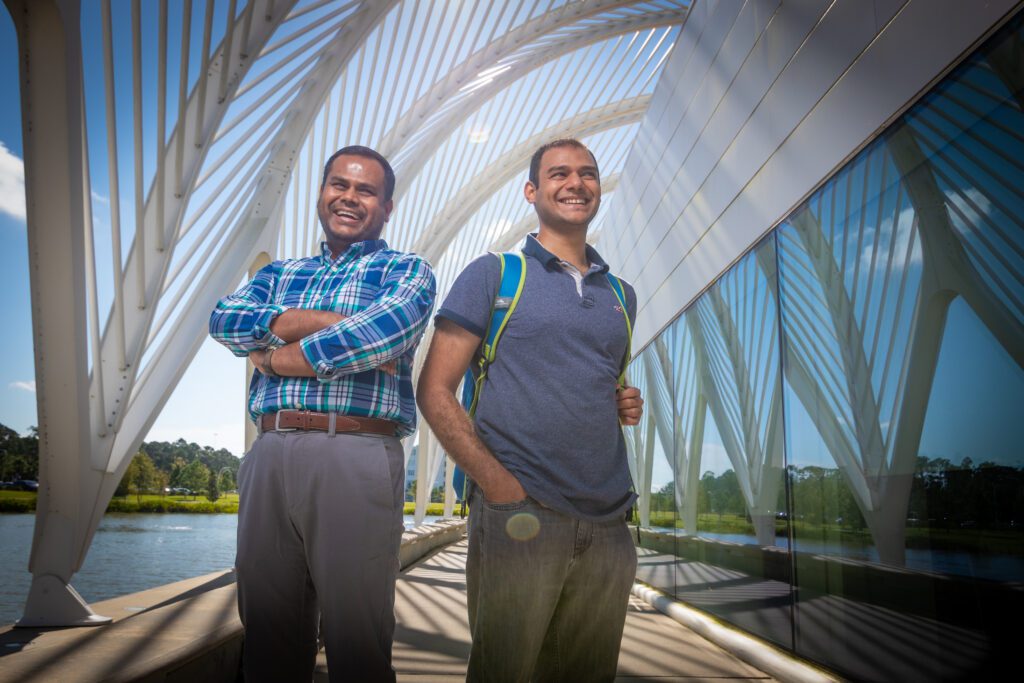Florida Polytechnic University Conducting Research on Fetal and Maternal ECG Signals
by MARY TOOTHMAN
Florida Polytechnic University’s Dr. Muhammad Ullah, professor of computer engineering, is hard at work on a project that has the potential to save the lives of babies.
It would be difficult to find fault with a goal like that.
“The project is about extracting and processing the electro-cardiogram signals of the mother (MECG) and the fetus (FECG) so that any heart-related diseases can be diagnosed in time, and proper treatment can be provided to save these lives,” he says.
The Lakeland-based Florida Polytechnic University is the ideal place for such research, he says. Dr. Ullah joined Florida Polytechnic as an assistant professor of electrical and computer engineering.
He was offered a graduate-level course last fall called Advanced Digital Signal Processing, along with an undergraduate-level course called Digital Signal Processing. Thirty-eight students are enrolled.
“One of the requirements of the graduate level course is to conduct research that will greatly impact society,” he says.
Florida Poly’s president, Dr. Randy K. Avent, says this project is a good example of the many ways the university is able to apply research and its talent to projects that improve society.
“We are very proud of the research work that Dr. Ullah has done to improve the way fetal and maternal electrocardiography signals can be obtained more accurately,” Avent says. “Knowing that this break-through research could save lives by enabling doctors to prescribe a more appropriate treatment is really rewarding.”
As a signal processing specialist, Dr. Ullah was already familiar with some shortcomings of existing fetal monitoring capabilities. “ I tried to identify the problem, and realized that scientists and engineers had been striving for more than a century to obtain nearly perfect fetal ECG and maternal ECG signals out of a feto-maternal ECG (F/M ECG) complex signals.
“More than one percent of infants die every year due to confusion created by inaccurate fetal and maternal ECG signals. Doctors need to have the most accurate data to be able to save lives,” he says.
He began to form ideas. “I was thinking: ‘How can I solve this problem in a more simplistic, cost-efficient way?’ So I assigned this project to my student, and we got to work.”
They began to more fully develop the concept in the fall of 2017. The undertaking will take time. “We are further developing the software and working to enhance its efficiency,” Dr. Ullah says. “It will take at least two years to complete the software development, implement the project in hardware, and design it as a final product.”
He finds the work extremely fulfilling; and time invested well worth it. “Life is very important, and the life of a baby who has yet to be born — and the mother, who is carrying this baby inside her womb — means everything to us,” he says.
Studies have shown that one out of every 125 to 150 infants suffers from congenital heart failure, he says. “We can save about 30,000 lives each year with the simple, cost-effective, and accurate ECG processing mechanism that we are researching and developing in this project.”
Two people are working on the project currently, including Ullah. “I have a graduate student from Pakistan, Mohammad Ammar Bharmal,” he says. Officially, Bharmal is leading the project and Ullah supervises his work.
On a personal and professional level, Dr. Ullah is fired up about the possibilities. “I am very excited for this project, and have plans to realize it in product form at a low cost.
“I believe that this project can be of immense significance in the field of medical science to diagnose fetal ECG and maternal ECG signal more accurately and more economically — while keeping it less computation intensive.
“The message I would like to convey is that together, engineers and doctors can make this world a better place. We can bring a huge positive impact to our society by saving lives.”
Florida Polytechnic University was founded with a strong spirit of collaboration and community involvement.
Avent says this project is in line with the university’s goals and values. “Applied research is an integral part of our curriculum at Florida Poly, and the involvement of students is a key part of its success,” he says. “Growing our research is one of our goals during the next five years, and we foresee a growing relationship with industry that will foster that growth.”
Dr. Ullah says he feels fortunate to be at the university, where his interests are valued and he is granted the time to conduct the research. “Industrial collaboration through the University will encourage accomplishing meaningful and impactful results. I am very optimistic about potentially collaborating with other interested professions. I look forward to working together to greater benefit society.”
Avent says Florida Poly seeks out individuals with backgrounds and interests that are in line with the university’s culture.
“Dr. Ullah has a remarkable research background and has made great contributions to Florida Poly as an assistant professor of electrical and computer engineering,” Avent says. “As our institution matures, we’ll continue to look for more professors like him, who are committed to excellence in teaching as well as in research.”
Bio — Dr. Muhammad Sana Ullah
An assistant professor of electrical and computer engineering at Florida Polytechnic University, Dr. Ullah is a UMKC SGS Research Grant fellow and Preparing Future Faculty fellow, he received Ph.D. and MS degrees in Electrical and Computer Engineering from the University of Missouri-Kansas City (UMKC) in May 2016 with VLSI concentration, and Purdue University Calumet (Purdue-Calumet) in May 2013 with communication and signal processing concentration, respectively. He was awarded bachelor’s degrees in Electrical and Electronic Engineering from Chittagong University of Engineering and Technology, Bangladesh in 2008. His specific research focuses are signal processing for deception detection, analysis and synthesis of ECG and EKG signals, modeling of interconnects in high-density integrated circuits and energy efficient electronic devices.
